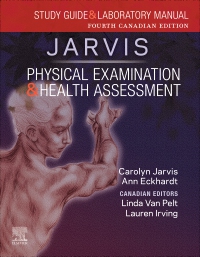
Study Guide and Laboratory Manual for Physical Examination and Health Assessment, Canadian Edition, 4th Edition
Paperback

Reinforce your students’ understanding of essential examination and assessment skills and further develop their clinical judgement! As both a comprehensive lab manual and a practical workbook the Study Guide & Laboratory Manual for Physical Examination & Health Assessment, 4th Canadian Edition provides students with activities and resources to enhance hands-on learning of physical examination skills. It features reading assignments corresponding to the text, terminology reviews, application activities, review questions, clinical learning objectives, documentation sheets, and narrative summary forms, with answers on the companion Evolve website to facilitate both learning and review. Electronic health record and evidence-informed practice materials further improve upon skills.
-
- NEW! Preface includes an overview of the NCSBN® Clinical Judgement Measurement Model, PN competencies, and the REx-PN®
- NEW! Clinical judgement exercises equip students for success on the Next Generation NCLEX® (NGN), including questions with an increased focus on clinical judgement
- Updated content throughout corresponds to the 4th Canadian edition of the textbook and incorporates the latest research and evidence-informed practice
- Consistent chapter format includes the following sections: Purpose, Reading Assignment, Glossary, Study Guide, and Review Questions including clinical judgement. Core body systems chapters also include a Skills Laboratory/Clinical Setting section, including Clinical Objectives, Instructions, and a regional Documentation sheet to be completed
- Chapters correspond one-to-one with chapters in the textbook to provide essential review and guidance for clinical laboratory experiences
- Critical thinking exercises included in many chapters offer suggested readings based on student participation in the skills lab and discussions with instructor
- Audio-visual assignments with related Critical Thinking Questions tie the visual video demonstrations of specific examination procedures to practical applications in the skills lab
- Coverage of the electronic health record, charting, and narrative recording gives students examples of how to document assessment findings
- Anatomy labelling exercises visually reinforce the identification of key anatomy and physiology
- Study guide activities reinforce key assessment information through short-answer, fill-in-the-blank, and labelling exercises
- Perforated pages allow instructors to use the Study Guide activities for graded assignments
- Reading assignments correspond to the text chapters to foster integration of the text and laboratory manual
- Documentation Sheets allow students and faculty to assess knowledge with forms used in the skills lab or clinical setting
- Current RN and PN competencies are reflected throughout to help students better prepare for licensure examinations
- Review questions — short answer, matching, multiple choice — provide learning activities in a variety of approaches
- Narrative Summary Forms reflect the charting format used for narrative accounts of the history and physical examination findings
- Glossary promotes learning and understanding of essential terminology
- Answer key on the companion Evolve website includes answers to all questions
-
- NEW! Preface includes an overview of the NCSBN® Clinical Judgement Measurement Model, PN competencies, and the REx-PN®
- NEW! Clinical judgement exercises equip students for success on the Next Generation NCLEX® (NGN), including questions with an increased focus on clinical judgement
- Updated content throughout corresponds to the 4th Canadian edition of the textbook and incorporates the latest research and evidence-informed practice
-
UNIT 1 ASSESSMENT OF THE WHOLE PERSON
1. Critical Thinking and Evidence-Informed Assessment
2. Health Promotion in the Context of Health Assessment
3. A Relational Approach to Cultural and Social Considerations in Health Assessment
4. The Interview
5. The Complete Health History
6. Mental Health Assessment
7. Substance Use and Health Assessment
8. Interpersonal Violence and Health Assessment
UNIT 2 APPROACH TO THE CLINICAL SETTING
9. Assessment Techniques and the Clinical Setting
10. General Survey, Measurement, and Vital Signs
11. Pain Assessment
12. Nutritional Assessment and Nursing Practice
UNIT 3 PHYSICAL EXAMINATION
13. Skin, Hair, and Nails
14. Head, Face, and Neck, Including Regional Lymphatic System
15. Eyes
16. Ears
17. Nose, Mouth, and Throat
18. Breasts and Regional Lymphatic System
19. Thorax and Lungs
20. Heart and Neck Vessels
21. Peripheral Vascular System and Lymphatic System
22. The Abdomen
23. Anus, Rectum, and Prostate
24. Musculo-Skeletal System
25. Neurological System
26. Male Genitourinary System
27. Female Genitourinary System
UNIT 4 INTEGRATION OF THE HEALTH ASSESSMENT
28. The Complete Health Assessment: Putting It All Together
29. Bedside Assessment and Reporting
30. Pregnancy
31. Assessment of the Older Adult
32. Next Generation NCLEX® (NGN) Examination–Style Unfolding Case Studies
Appendix
Answer Key—available on the text’s Evolve site



 as described in our
as described in our 